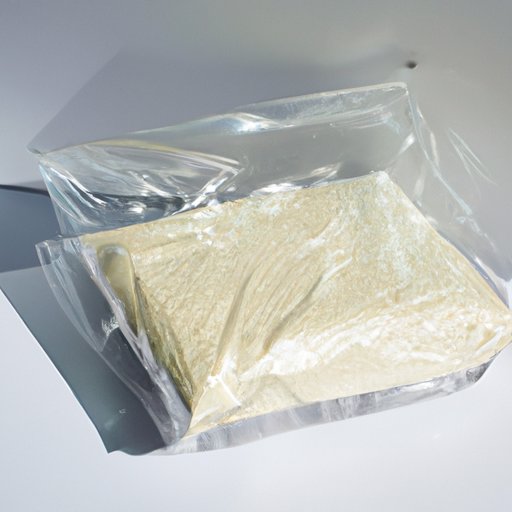
I. Introduction
Many of us use plastic wrap to keep our food fresh and prevent spills in the microwave. But have you ever wondered whether it’s safe to microwave plastic wrap?
In this article, we explore the safety concerns surrounding microwaving plastic wrap and provide tips for alternative options. Whether you’re concerned about your health or want to reduce your environmental impact, understanding the facts can help you make informed choices about your food storage and preparation.
II. Microwave-Safe Plastic Wrap: What You Need to Know
Microwave-safe plastic wrap is specially designed to withstand the heat of the microwave without melting or releasing harmful chemicals. Unlike regular plastic wrap, which can warp or melt when exposed to heat, microwave-safe wrap is made with materials that are less likely to break down or leach chemicals into your food.
Microwave-safe plastic wrap also offers several benefits over other types of plastic wrap. For example, it can help reduce splattering in the microwave, making cleanup easier and preventing food from drying out. It can also help prevent contamination in the fridge, keeping your food fresh for longer periods of time.
III. The Dangers of Microwaving Plastic Wrap: A Scientific Perspective
While microwave-safe plastic wrap is designed to be safe for use in the microwave, there are still potential risks associated with microwaving any type of plastic.
One concern is the potential for chemical leaching. When plastic is exposed to heat, it can release harmful chemicals into your food, such as BPA, phthalates, and styrene. These chemicals have been linked to a range of health problems, including hormonal imbalances and increased risk of certain cancers.
Another risk is the potential for melting. When plastic wrap melts in the microwave, it can create a mess and potentially release harmful chemicals into your food.
Scientific studies have supported these concerns. For example, a study published in the Journal of Environmental Science and Health found that plastic wrap releases high levels of chemicals when heated in the microwave. Another study published in the International Journal of Hygiene and Environmental Health found that plastic wrap containing phthalates released these chemicals into acidic foods when heated.
IV. Reduce Your Plastic Footprint: Alternatives to Microwaving Plastic Wrap
If you’re concerned about the environmental impact of plastic wrap, there are several alternative options to consider.
One option is to use glass or ceramic containers for food storage instead of plastic wrap. These materials are generally safer for use in the microwave and can be reused many times. Another option is to use reusable silicone food covers, which can be placed over bowls or plates to create a seal without the need for plastic wrap.
By reducing your use of plastic wrap, you can help cut down on plastic waste and minimize your impact on the environment.
V. Microwaving Plastic Wrap: Step-by-Step Safety Guide
If you do choose to microwave plastic wrap, there are certain precautions you can take to minimize the risks.
First, make sure to select plastic wrap that is labeled microwave-safe. This type of wrap is specifically designed to withstand the heat of the microwave and reduce the risk of melting or chemical leaching.
Before microwaving, make sure to vent the plastic wrap to prevent a buildup of steam. This can be done by creating small openings in the wrap with a fork or knife or by loosely draping the wrap over the food instead of creating a tight seal.
After microwaving, be careful when removing the plastic wrap from the food. The wrap may be hot and can stick to the food, potentially causing burns.
VI. Exploring the Health Risks of Microwaving Plastic Wrap
In addition to the environmental and safety concerns surrounding plastic wrap, there are also potential health risks to consider.
One study published in the Journal of Environmental Health Perspectives found that exposure to certain chemicals found in plastic wrap, such as DEHP and DINP, may be linked to increased risk of type 2 diabetes. Other studies have suggested a link between exposure to phthalates found in plastic wrap and decreased fertility in women.
To minimize these risks, it’s best to avoid microwaving fatty or acidic foods with plastic wrap, as these foods are more likely to cause the plastic to break down and release harmful chemicals. Instead, consider using a glass or ceramic container or covering the food with a microwave-safe plate or lid.
VII. From Takeout to Leftovers: Safe Practices for Microwaving Food with Plastic Wrap
If you frequently microwave takeout food or leftovers that come with plastic wrap, there are certain safety precautions you should take.
First, make sure to remove any excess plastic wrap before microwaving, as this can create a fire hazard. Next, consider transferring the food to a glass or ceramic container before microwaving, as this can be a safer alternative to using plastic wrap. When removing the plastic wrap from hot food, be sure to use oven mitts or a towel to avoid burns.
VIII. Conclusion
While it’s possible to microwave plastic wrap safely if you take the proper precautions, there are still potential risks involved. By using microwave-safe plastic wrap or alternative options such as glass containers or silicone covers, you can minimize your exposure to harmful chemicals and reduce your environmental impact.
Ultimately, the choice of whether or not to microwave plastic wrap is up to you. By understanding the facts and taking steps to reduce your use of plastic wrap, you can make informed choices about your food storage and preparation.




